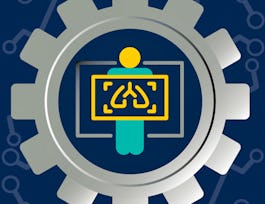This course teaches you the fundamentals of computational phenotyping, a biomedical informatics method for identifying patient populations. In this course you will learn how different clinical data types perform when trying to identify patients with a particular disease or trait. You will also learn how to program different data manipulations and combinations to increase the complexity and improve the performance of your algorithms. Finally, you will have a chance to put your skills to the test with a real-world practical application where you develop a computational phenotyping algorithm to identify patients who have hypertension. You will complete this work using a real clinical data set while using a free, online computational environment for data science hosted by our Industry Partner Google Cloud.



Identifying Patient Populations
This course is part of Clinical Data Science Specialization

Instructor: Laura K. Wiley, PhD
Sponsored by ITC-Infotech
3,483 already enrolled
(39 reviews)
Recommended experience
What you'll learn
Create a computational phenotyping algorithm
Assess algorithm performance in the context of analytic goal.
Create combinations of at least three data types using boolean logic
Explain the impact of individual data type performance on computational phenotyping.
Details to know

Add to your LinkedIn profile
7 assignments
See how employees at top companies are mastering in-demand skills

Build your subject-matter expertise
- Learn new concepts from industry experts
- Gain a foundational understanding of a subject or tool
- Develop job-relevant skills with hands-on projects
- Earn a shareable career certificate


Earn a career certificate
Add this credential to your LinkedIn profile, resume, or CV
Share it on social media and in your performance review

There are 5 modules in this course
Learn about computational phenotyping and how to use the technique to identify patient populations.
What's included
5 videos10 readings2 assignments
Understand how different clinical data types can be used to identify patient populations. Begin developing a computational phenotyping algorithm to identify patients with type II diabetes.
What's included
5 videos2 readings2 assignments
Learn how to manipulate individual data types and combine multiple data types in computational phenotyping algorithms. Develop a more sophisticated computational phenotyping algorithm to identify patients with type II diabetes.
What's included
2 videos2 readings2 assignments
Understand how to select a single "best" computational phenotyping algorithm. Finalize and justify a phenotyping algorithm for type II diabetes.
What's included
1 video1 reading1 assignment
Put your new skills to the test - develop an computational phenotyping algorithm to identify patients with hypertension.
What's included
1 reading1 peer review
Instructor

Offered by
Why people choose Coursera for their career




Learner reviews
39 reviews
- 5 stars
71.79%
- 4 stars
17.94%
- 3 stars
2.56%
- 2 stars
0%
- 1 star
7.69%
Showing 3 of 39
Reviewed on May 12, 2019
This is a well-presented course. I highly recommend.
Reviewed on Dec 12, 2019
Great overview of how to identify Patient Population and the in and out of what to look for when you are thinking about your potential research project will involve.
Reviewed on Apr 4, 2019
The instructor does a great job of providing hands-on teaching in addition to lecture. However, this course required a lot of knowledge of R, which wasn't provided in the introductory course.
Recommended if you're interested in Data Science

Coursera Project Network

University of Michigan

Icahn School of Medicine at Mount Sinai

University of Michigan

Open new doors with Coursera Plus
Unlimited access to 10,000+ world-class courses, hands-on projects, and job-ready certificate programs - all included in your subscription
Advance your career with an online degree
Earn a degree from world-class universities - 100% online
Join over 3,400 global companies that choose Coursera for Business
Upskill your employees to excel in the digital economy


